Sony A9G (US) - AG9 (UK/Europe)
Product Name: Sony A9G (US) - AG9 (UK/Europe)
Product Description: 2019 4K UHD OLED TV
-
Design - 9/10
9/10
-
Video Quality - 9.5/10
9.5/10
-
Inputs and Ports - 8.8/10
8.8/10
-
OS, Apps and Features - 9.2/10
9.2/10
-
Price / Quality - 9.2/10
9.2/10
Summary
Total Score
Pros
- Excellent image quality
- Very good motion performance
- Lots of features and services
- Future updates
Cons
- No major upgrade over last year
- No HDR10+ support
- Input lag could be better
- Higher price than competition
Cheapest Places to Buy :
*We are a reader-supported website. When you buy through links on our site, we may earn a small affiliate commission at no extra cost to you. Home Media Entertainment does not accept money for reviews.*
With only two OLED models in Sony’s lineup for 2019 we get a rather limited amount of options if you are specifically eyeing to get a Sony OLED this year. The A9G or AG9 if you live in UK/Europe is the cream of the crop as far as Sony OLED technology is concerned and is part of what the Japanese manufacturer calls “Master Series” which they consider the premium lineup that consists of the A9G as well as the less capable A8G (AG8 in UK/Europe).
The A9G is directly replacing last year’s A9F and you will be able to find it in three different sizes as 55″, 65″ and 77″ are the ones available in all markets. This model as you can imagine packs all the latest tech with an OLED panel that can display breathtaking blacks, Sony’s new X1 Ultimate processor that according to Sony packs twice the processing power of the previous X1 Extreme silicone, uses the “Acoustic Surface Audio+” system for audio that utilizes the TV screen as a huge membrane to produce sound, comes with Dolby Vision and Dolby Atmos support while it features the Android smart TV platform with a wealth of streaming and online apps available. And if all these are not enough Sony has promised to add Airplay 2 and HomeKit through an update sometime this year.
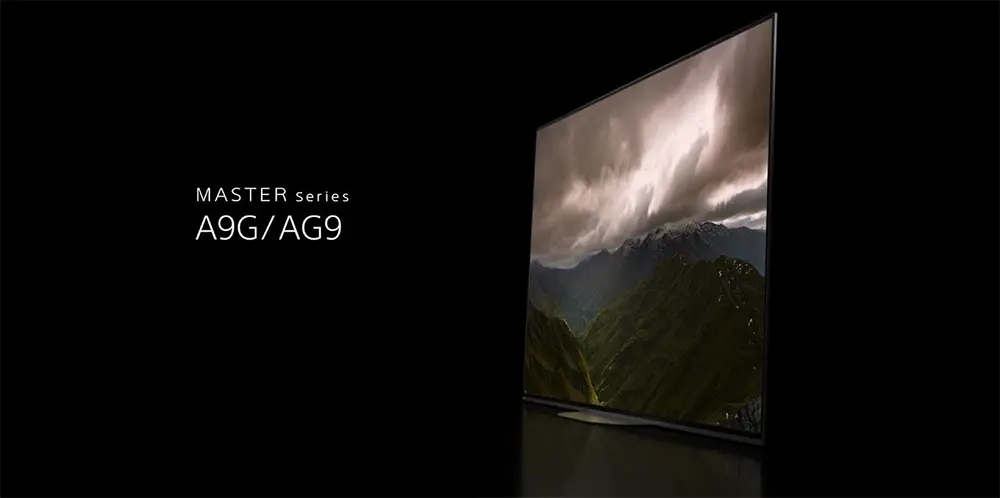
The A9G seems like a powerhouse in specs as it features everything you would expect from such a high end model and more. But does it manages to distinguish itself from the competition or have we reached a point that brand preference and price differences is what matters the most? Continue reading our Sony A9G review to find out.
Design
The A9G features a very different design compared to the A9F it is replacing. And while many will argue that A9F’s design was nice at least it was rather unique with it’s back stand. This year Sony decides to go for a more conventional design and uses a very thin central stand that keeps the TV stable. Being an OLED means that the panel is extremely thin with a maximum thickness of 4cm at the bottom where the electronics box is placed. The TV also features very thin and elegant borders making them almost non visible from a certain distance.
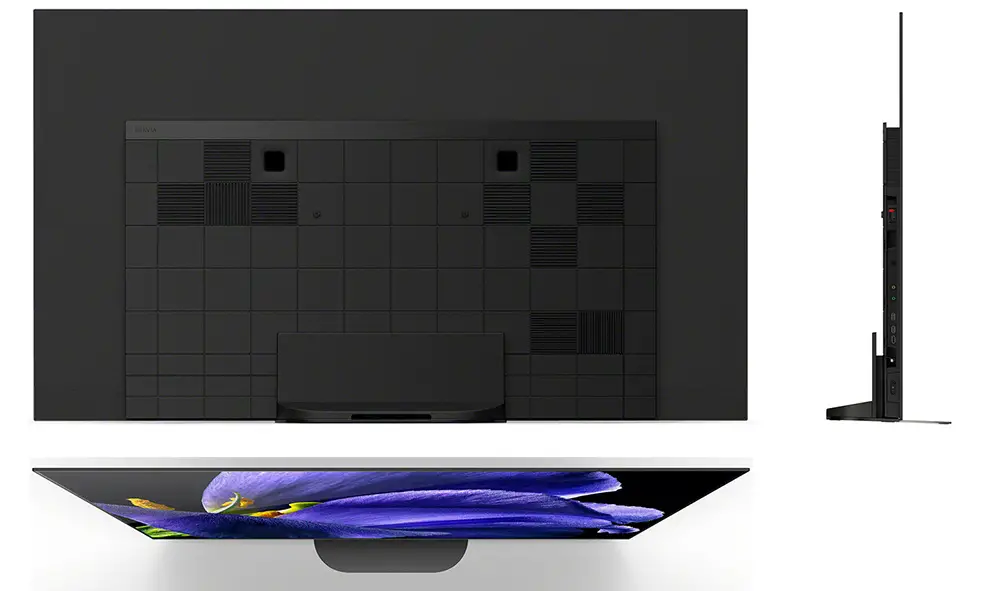
The back of the TV features a rather interesting design with squares covering the plastic parts that hide the electronics and connection ports. Some plastic parts are used as covers that you can take out and put back again when you finish connecting all cables. Cable management is pretty standard and you can guide all wires through a single exit in order to look better altogether. It’s not as good as One Connect Box but it will do the job just fine.
The included stand has a pretty small footprint making it easier to place the TV on smaller furniture although it can make the unit wobble a little. We should mention that due to it’s extreme thickness the unit stays relatively close to where it’s placed making it impossible to place a soundbar in front of the panel as it will cover the lower part of the screen. But in general we like it’s thin design with it’s round corners as it helps the whole unit have a rather minimalistic look.
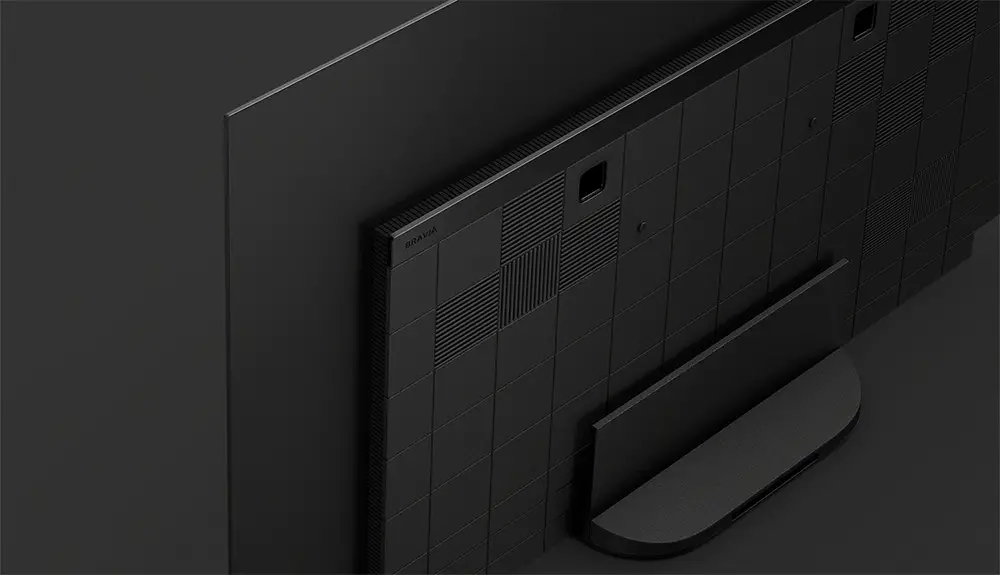
As for the included remote the one that we get here is exactly the same as the one we saw in the X950G and it features a metal surface while it’s overall design has improved dramatically compared to the plastic one we were getting for many years. The number of buttons is reduced a bit while the layout remained very similar making it overall less cluttered and more practical. Most buttons have a circular design while their size is ok although for some of them we would like them a bit bigger.
At the top we find a numerical pad with 2 dedicated buttons for Google Play and Netflix below, the classic menu navigation control, volume and channel controls below them and finishing with the usual playback buttons at the bottom. He had mentioned before that the new remote is a step to the right direction and while it still cannot compare to the likes of Samsung or LG offerings it is vastly better than the low quality plastic one we were getting for many years and didn’t follow the premium stature of the corresponding TV models it was coming with.

Video Quality
Processor technology used
The A9G comes with the latest processor from Sony called X1 Ultimate and we had already seen what this is capable of when we reviewed the Sony X950G. The manufacturer claims that X1 Ultimate packs almost twice the processing power of it’s previous incarnation, the X1 Extreme, and it’s particularly capable with it’s object based rendering.
Other new technologies that this new chip includes are called Object-based HDR remaster and Object-based Super Resolution with the first one analyzing the contrast in individual objects on screen and adjust the contrast accordingly while the later auto-detects objects on screen and increases their resolution individually.
Another of it’s advanced feature is that it’s especially capable in converting SDR content to HDR which may sound like a nice feature to have but we should mention that additional processing changes the picture from what it was meant to be and we definitely prefer our content to be displayed as pure as possible. But in general the X1 Ultimate is a serious piece of tech that Sony was teasing from CES 2018 showing how much they count on this latest chip.
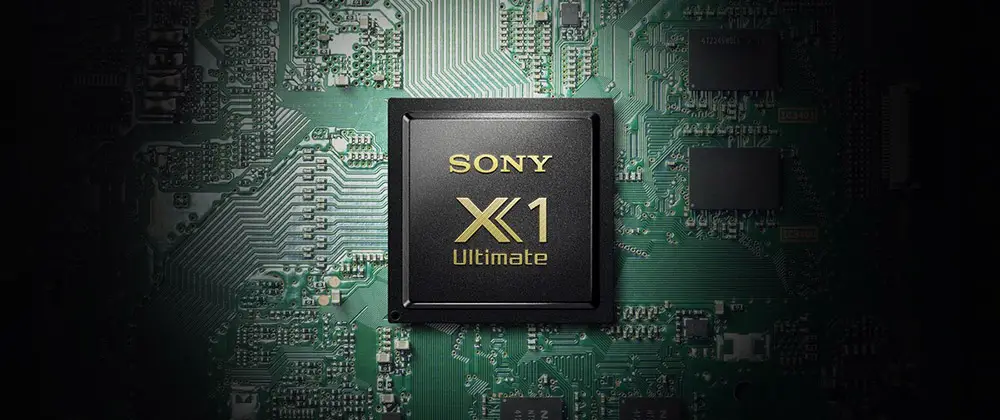
Lighting technology used
OLED no doubt offers some of the best image quality we have seen on TVs till now and one of their key characteristic in achieving this quality is that unlike LED LCD TVs that use backlights these don’t need any to function. Turning on and off their individual pixels is a major advantage any OLED panel has as this means that it can offer true deep black levels as well as they don’t exhibit what is called blooming that plagues LCD TVs.
Blooming is a halo or bright ring if you prefer that appears around bright objects in a completely dark background. This happens because light leaks to nearby pixels due to the backlight. An OLED with it’s self emitting pixels don’t have this problem and the results are breathtaking. OLED is the pinnacle of TV image technology right now and it seems will remain as such until some other new technology manages to surpass it.
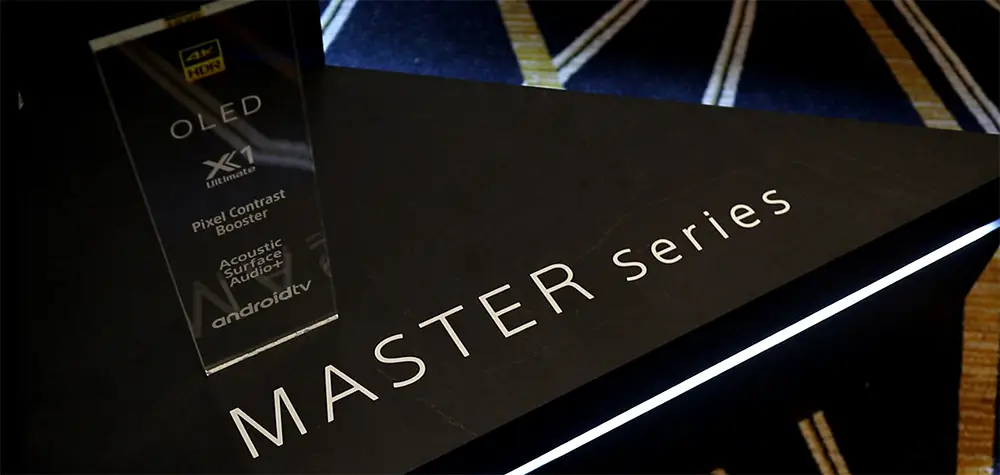
Brightness / Contrast
OLED’s number one problem was always brightness. In the early years we were able to see small improvements in this regard on yearly new models but the last couple of years this seems to have reached a plateau as we are seeing similar or in some cases worse numbers even if with a naked eye this is not so obvious. Something similar seems to be happening with the A9G also.
Accrding to our measurements the A9G is capable of 424 nits of SDR brightness in a 10% window which is more than fine if you consider that SDR content never had excessive needs for brightness making this number more than adequate while in HDR brightness our measurements on a 10% window revealed 630 nits. This number could be considered adequate but in no way it can compete with some of the top LED LCD models that are capable of producing more than 1,000 nits. The number that the A9G showed us place it at the same league as last year’s A9F while they seem to be slightly reduced.

As for contrast having an OLED panel means that the A9G can switch off it’s pixels entirely meaning it gains infinite contrast ratio resulting in true deep blacks compared to greyish blacks we see in many LCD models while it’s panel uniformity is also extremely good. One thing we should mention is about permanent image retention which is a hot topic among OLED fans. For this we recommend to turn on Pixel Shift from the TV settings and run Panel Refresh as frequently as Sony suggests. Also keep in mind that long gaming or broadcasting sessions can make certain logos or static graphics to burn-in but since this is not to a certain thing you should always change the image every few hours just to be on the safe side.
Lastly we should mention that the A9G showed the same behavior during static HDR images as we had seen in the A9F where the panel reduces it’s brightness almost 50% over a period of time in order to protect the panel from permanent burn-in. This will most probably go unnoticed by most as the reduction is happening gradually and it’s not obvious to someone that keeps looking at the TV but it’s an effect that it’s there and we should mention it. When the screen refreshes with a new image brightness returns to it’s peak value until another static image is detected and the gradual reduction starts again.

Viewing angles
Viewing angles is another strong point that we find in all OLED panels making them ideal if you are planning to have viewing positions at not so ideal angles. LED LCD manufacturers were always struggling with this and have used various techniques in recent years to improve this situation but even as such OLED TVs will offer much more extreme angles than any LCD TV can offer and retain a much better image quality.
The same can be said about the A9G as we found that until 50 degrees angle it retained a very acceptable image quality. You can view at even greater angles than that but color deterioration and brightness loss start to become a little obvious. But 50 degrees is far better than any LCD panel can achieve and it can be considered one of the highlights of this model.
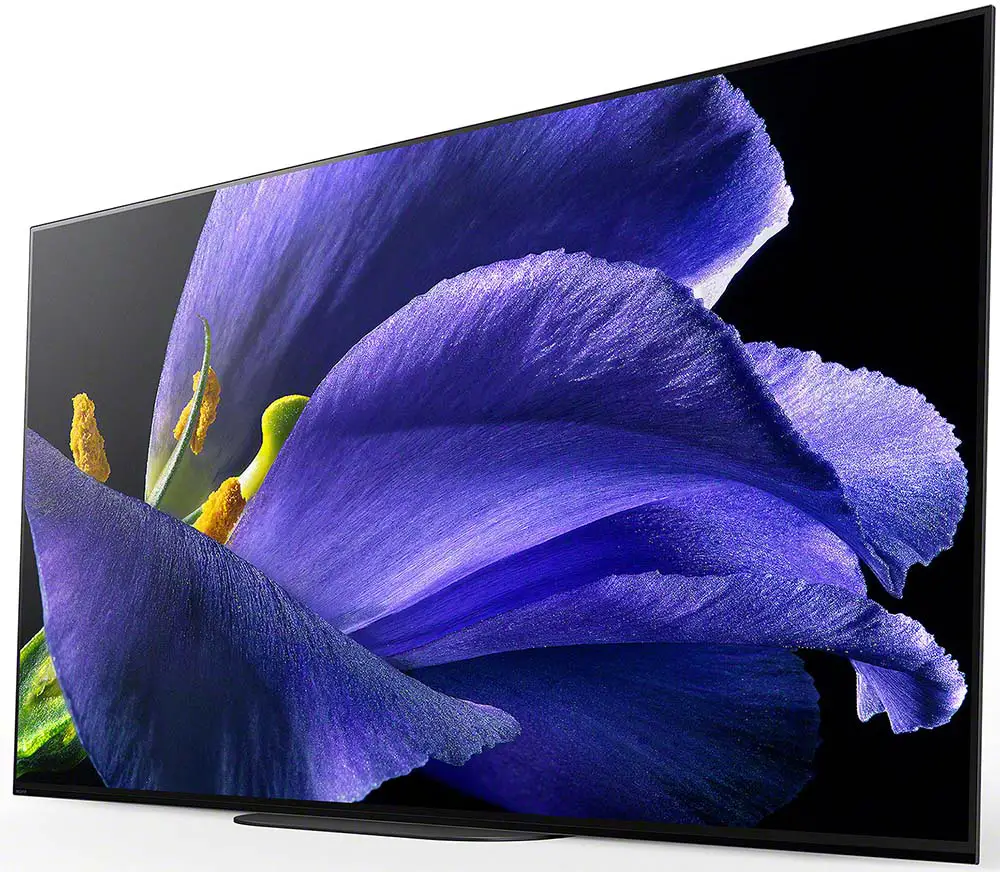
HDR support
The A9G supports three HDR protocols at the moment with the basic HDR10 that is required for UHD playback, HLG that is used in broadcasting and streaming media as well as Dolby Vision that is a more advanced protocol that uses dynamic metadata for more accurate and better image quality. As with all Sony models in 2019 there is no HDR10+, which is similar to Dolby Vision but it doesn’t have the royalties that Dolby asks from manufacturers, and it will be interesting to see if there will be support for it with a future update when it becomes more widespread in consumer media.
Color coverage
A9G supports Wide Color Gamut which means it is capable at displaying more realistic and vivid colors. We measured the color coverage in the DCI-P3 color space and it gave us a result of 96% coverage which is extremely good while measurements in the wider REC.2020 color space gave us a 72% result. These numbers indicate that the A9G performance is just slightly lower than last year’s A9F but the difference is so small that you wouldn’t be able to tell the difference by just looking both panels even if you would compare them side by side. Great overall results here showing how good the A9G can handle colors.

Motion performance
When it comes to motion performance Sony was always at the top of the game offering top quality motion the last few years making all other manufacturers playing catch up. For one more year we find Sony’s Motion Flow technology which is considered one of the best combined with a 120Hz panel in order to minimize blur and judder during fast panning of the camera. There is also the optional BFI (black Frame Insertion) feature that smooths motion by inserting a black frame between two individual frames during playback. By inserting these black frames the TV is supposed to simulate flicker that can make motion appear smoother.
The BFI feature is a nice one but not without some undesired side effects. First of all as we mentioned it can make flicker appear and for some people this may be bothering. The second side effect is that due to the black frames the overall brightness is reduced making the image appear more dim. As always with all these motion interpolation systems you should be using low settings in order not to make the Soap Opera Effect appear.
Unfortunately the A9G does not support either Variable Refresh Rate (VRR), FreeSync or G-SYNC technologies. But in general we are very pleased with the kind of performance the A9G managed to give us.
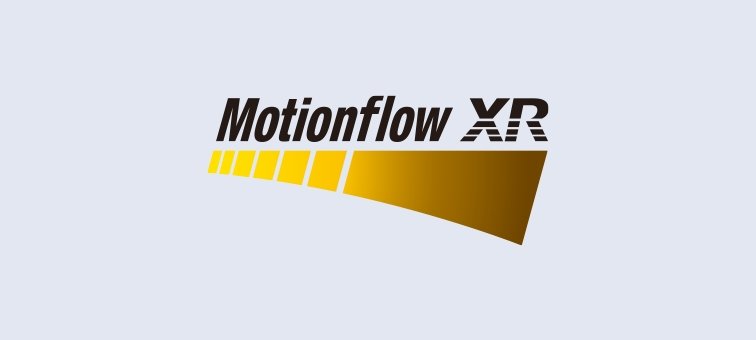
Input lag
Input lag on the A9G was measured at 27ms with Game mode enabled which is very good but not as low as some other models. Even this year’s Sony X950G was able to score better with only 21ms while some other OLED models like the LG C9 can go as low as 13.7ms. So while the A9G was able to score a very respectable 27ms we cannot consider this to be one of the best in comparison to what we seen so far this year.
Just for the sake of testing we tried a bit of Call of Duty WW2 on our PS4 and we had a very pleasant gaming session with our commands registering immediately and we didn’t notice any delay or unresponsiveness. If you are a casual gamer then you will have no problem whatsoever but even for more serious users we consider the 27ms to be a very acceptable number.
Image quality impressions
Finishing this part of our review we feel that while the A9G is a really amazing TV it’s not as clear an improvement over the A9F as we would hope. In fact both models are more similar than you would expect showing us that manufacturing of OLED panels have reached a critical point at which is hard to see any further improvements. But even like this OLED never stops to amaze us while the X1 Ultimate processor continues to produce amazing results. Input lag is good even if not the best, viewing angles are as good as any OLED panel can offer and motion performance is excellent as we were expecting from Sony. Brightness and color coverage are similar to last year, even a bit reduced, so don’t expect any real differences there.
If you look at the A9G individually there is nothing not to like but when you compare it to the A9F we would say that this yearly update doesn’t offer anything more making it look more like a rebrand rather than a completely new model. If you own a A9F then you shouldn’t worry at all with upgrading and you should consider the A9G only if you are looking entirely for a new TV.
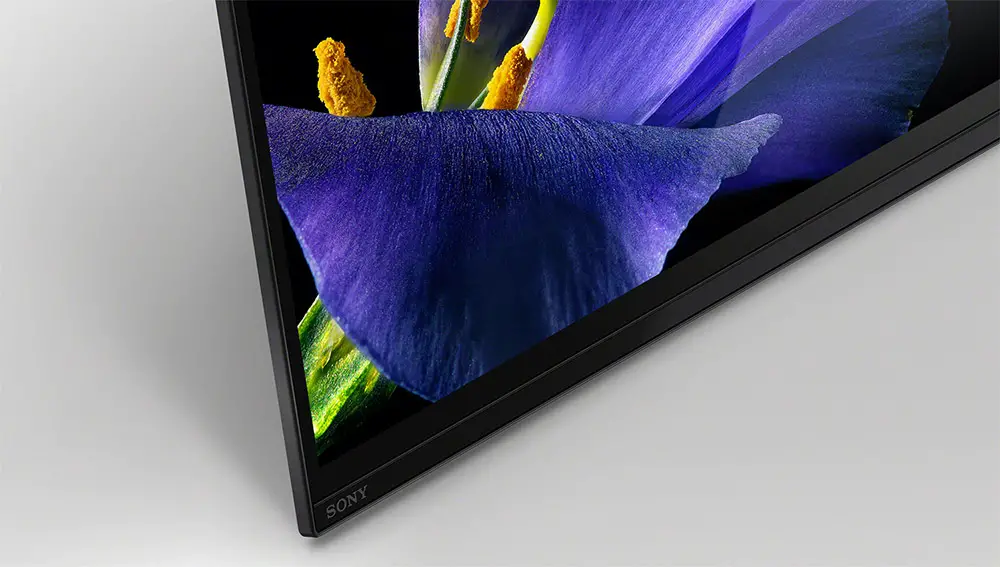
Audio Quality
Sound wise the A9G comes equipped with the same system we saw in last year’s A9F but featuring a small downgrade. The TV uses what Sony calls Acoustic Surface Audio+ technology which basically uses two actuators at the back of the panel that vibrate and use the whole panel as a huge membrane and thus create sound. This way it seems like audio is coming from within the screen giving you a better sense of realism.
But unlike last year’s A9F that used three such actuators the A9G uses only two delivering a 2.2 channels system compared to the 3.2 channels of the A9F. The difference is very small but we are curious why Sony decided on this downgrade even if they claim that this year’s actuators have been improved compared to last year. Having this unique feature with sound coming from the panel itself means that the A9G can also be used as a center channel in a surround setup and that’s why the TV has built-in speaker terminals.
In total the acoustic result is average and while more than enough for casual use if you want to use the TV on a home theater or if you plan to watch a lot of movies then a dedicated surround audio system is the best way to go.
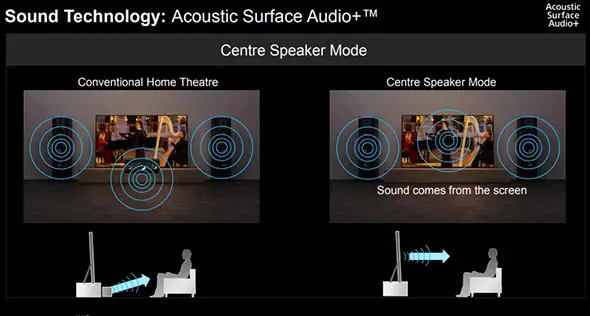
Inputs
As with all Sony TVs all ports and connections are placed on the main body of the TV. We really hope at some point Sony and LG will follow Samsung’s design with the One Connect Box but so far we haven’t seen any indication to do so.
The connections on the A9G are separated into two groups. One of them is looking sideways while the second group is facing downwards. Both groups directions definitely help if you plan to wall mount the unit as any backwards connections would make them hard to reach in such a case.
Starting with the ones looking sideways we find one HDMI port with a couple of USB ports above it for connecting external storage devices. Above them we see a couple of mini jacks, one for headphones and one composite input that needs a special adapter to work. Above these we get a remote IR input and at the very top we see speaker terminal inputs for the center channel.
Continuing at the second group from right to left we get another USB port, 3 HDMI inputs, an RS-232C port, an optical digital audio output, an Ethernet port if you prefer to connect the TV to the internet through a wire as well as the usual Antenna/cable input.
A couple of things we should mention here is that all HDMI ports are 2.0/HDCP 2.2 which means they support 4K, HDR at 60Hz. And while there are no HDMI 2.1 one of the ports comes with eARC support. Also from the total of three USB ports one of them is 3.0 meaning it can support higher transfer speeds. With LG already having HDMI 2.1 in many of their OLED models it feels like Sony is falling behind here. Although we are still in the early days of version 2.1 and not a lot of equipment support it it’s a feature missing compared to the competition and thus making the A9G less future proof.
OS, Apps and Features
The A9G features exactly the same software as the one we experienced during our X950G testing and comes equipped with exactly the same features. As such we find once again Android 8.0 Oreo powering it’s smart functionality which is a great upgrade and certainly brings it closer quality wise compared to Samsung’s Tizen and LG’s webOS. The number of improvements really surprised us the first time we experienced it during our Z9F review especially if you consider it’s state just a couple of years back.
Do we consider it as good as the other smart TV platforms? Well, not exactly but it comes damn close but with the amount of improvements we have seen lately it won’t be long before the three of them will be considered almost equal.
The first time we experienced Android 8 Oreo it managed to pleasantly surprise us as there has been a wide range of improvements in order to bring it closer to the streamlined experience that both webOS and Tizen could offer. And while some of the earlier Android versions would offer more headaches than needed this last edition see improvements almost all across the board with both small and big redesigns. The layout has a better feel now as options have moved on the top while many non-Android parts like Sony’s own operation system has also seen a major overhaul.
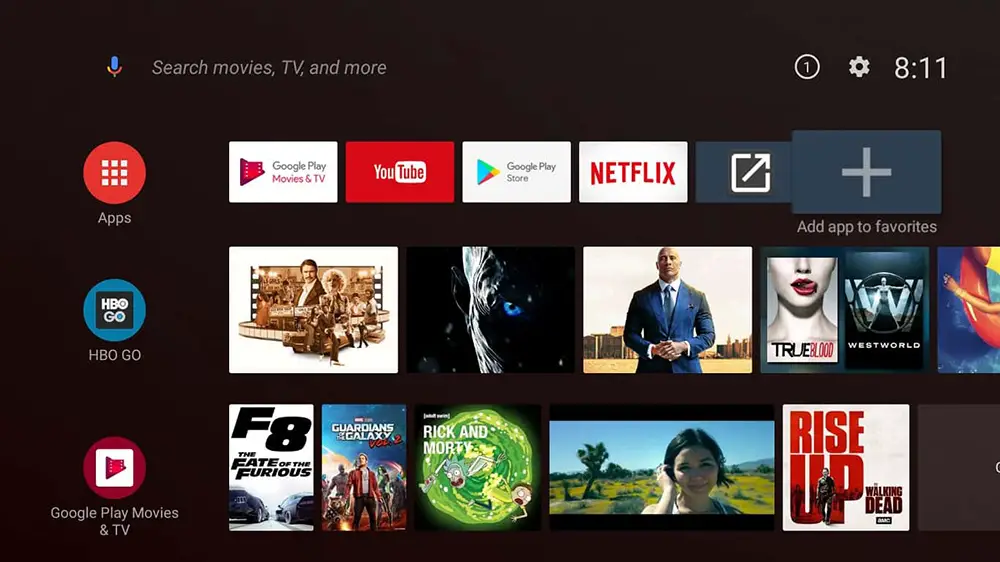
One problem we had seen many times in the past is that Android would make suggestions to the viewer that were not relevant to his viewing habits and many times it would suggest useless apps instead of what the user was looking for. This have seen a major upgrade as the new Android is much better at making suggestions depending on what you prefer to watch. Performance has also been improved as everything from navigation, opening apps and streaming is very fast and smooth something that probably has to do with a combination of better hardware as well as Android optimizations.
And while in many areas Android is still trailing a bit behind it’s competitors one area that was always strong at was it’s app support. With Google’s support and Google Play available there is an abundance of apps and streaming services available showing how much developers have supported Android over the years. Content services like Google Play TV & Movies, Netflix, Amazon Video, Hulu, Youtube and Sling TV are all present while for music streaming there is also Pandora, Spotify, iHeartRadio, Google Play Music and Tidal just to name a few.
The list goes on and on and a simple check on Google Play store will show you how much options you can have in this platform. Lastly we should mention that with various streaming services like Youtube and Netflix you can watch content with HDR something that was not possible before.

Chromecast is also supported and as such you can use it to stream content from any Chromecast enabled device like a smartphone or tablet to your TV. Sony has also equipped the A9G with microphones that are both built-in on the main body as well as the remote and in combination to the inclusion of both Amazon Alexa and Google Assistant voice services you can control various functions of your TV using only voice commands.
Functions that you can control through your voice include volume, channels changing, input selection, starting applications as well as doing content search. But voice functionality is not limited to controlling the A9G as your TV can become a central smart hub from where you can control all the smart devices in your home like lights, electronic locks, alarms and thermostats.
As with most TVs nowadays this one also includes a built-in media player that you can stream content from an external storage device. Support for video and audio files is pretty extensive and during our tests with it we didn’t notice any playback problems but you should keep in mind that the included player in no way can substitute a dedicated media player box. So if you have any weird container/format files the player may refuse to play them. But for the most usual formats it is more than adequate.
Another point that may be of importance is that Sony opts to update their Android TVs in order to add new functions and features compared to LG and Samsung where what you see is what you get. When they announced the new 2019 models they promised that some of their top tier models, including the A9G, will get an update in order to include Apple’s Airplay 2 as well as HomeKit.
Airplay 2 will let you stream content from an Apple device to your TV while with HomeKit you can gain control of your TV through an iPhone/iPad. Lastly the A9G is an IMAX Enhanced product but this remains to be seen what exactly this feature will offer when there will be commercially available IMAX Enhanced content.
Having already experienced Android 8 Oreo more than once we can say with confidence that the system has matured a lot since it’s early days. Yes it is still a bit behind competition but the distance between them has dramatically decreased making Android a very fine smart TV platform. As it goes soon we will not be talking if Android is behind the others but which we prefer more aesthetically.
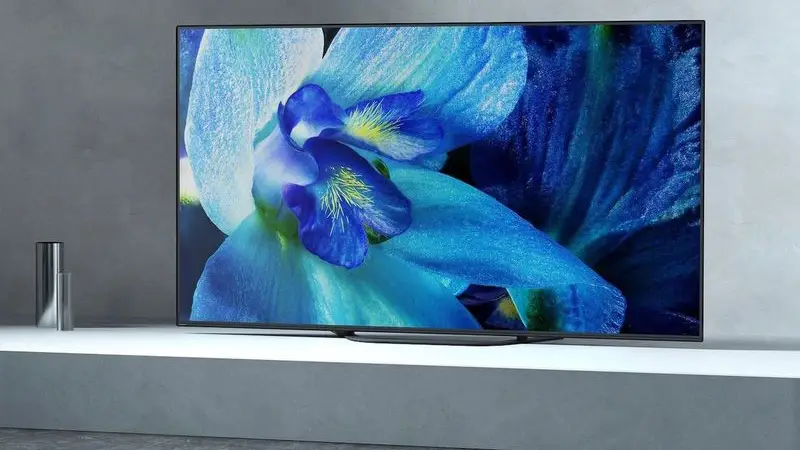
Final Thoughts
With the previous model in the series, the A9F, having a small lifespan it seems a bit of a strange move that Sony decided to release these new models so soon especially when there are not any major improvements to be found.
The A9G offers amazing image quality that is a result of the combination of an OLED panel with Sony’s new powerful X1 Ultimate processor. It also features very good color coverage, excellent motion performance, extreme viewing angles and an improved Android platform bringing it almost on par with the rest smart TV platforms. There is also Dolby Atmos, Dolby Vision and eARC support for those with systems that support these features while the promised update that will bring Apple’s Airplay 2 and HomeKit support is an added plus.
On the other hand one thing that we noticed is that there are certain key elements like brightness and color coverage that are the same or even a little bit worse than last year. And although these changes are very small to be noticed without special equipment it seems that we have hit a wall as further improvements with OLED tech is concerned. Unfortunately one thing that is completely missing is HDMI 2.1, although we get eARC, as all the ports are only 2.0b something that holds true for all Sony models in 2019, except the 8K Z9G. Lastly there is no HDR10+ support but hopefully we will be able to get that at some point in the future.
One decisive factor that will make or brake the A9G is it’s pricing. The TV is really amazing but right now it is priced more than some other OLED models without really offering any better image quality that is the most important factor that you will consider. If you can get it at a good price then by all means go for it as there are so many things to like in this one. Yes it may not be a clear improvement over last year’s A9F and in some areas it feels more like a rebrand rather than an entirely new model but the Sony A9G is a TV that deserves to be on the list of top OLED TVs for 2019 and thus deserves our high recommendation.
For more reviews you can check our dedicated 4K OLED TV reviews list or even look at our Product Reviews Table where you can find the brand and specific product you are looking for.
Cheapest Places to Buy :
*We are a reader-supported website. When you buy through links on our site, we may earn a small affiliate commission at no extra cost to you. Home Media Entertainment does not accept money for reviews.*
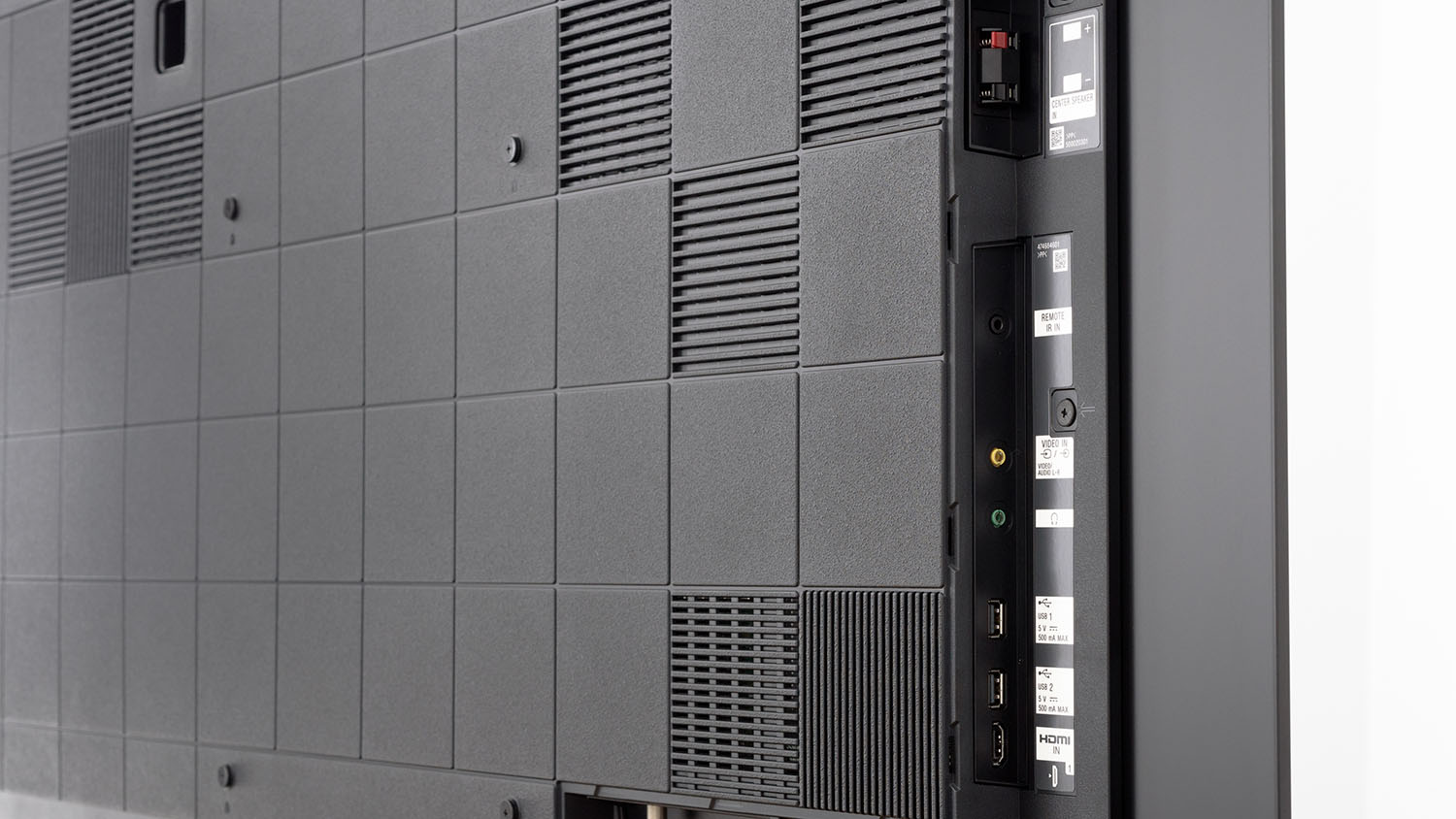
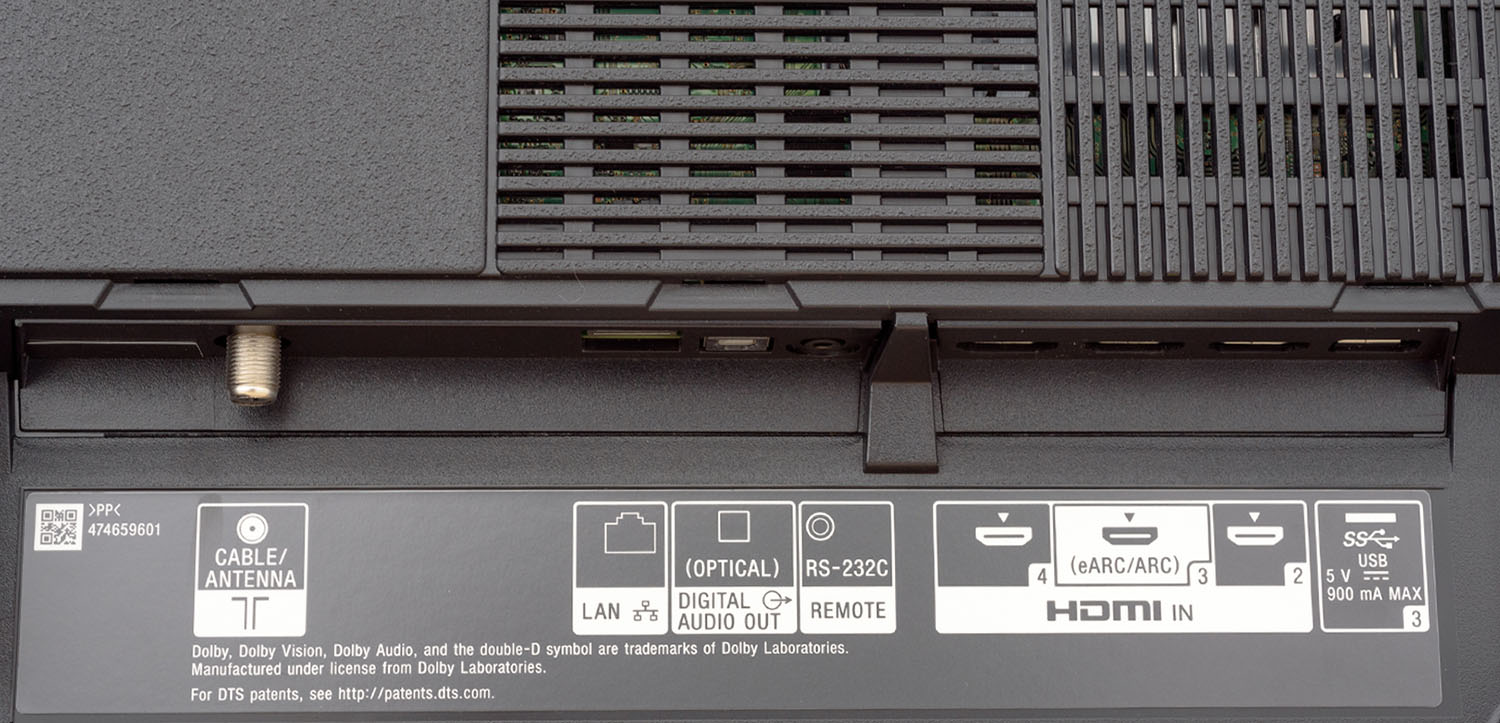
Sony has always been known to produce some of the best screens in ages. It’s is no surprise that the Sony A9G is a masterpiece too…with some downsides though. Well, I wouldn’t expect total perfection. I love Sony products and I have one of their TVs at home too. Maybe I’ll consider a future model that will have more improvements than what we get now.
Sony has made some great TVs over the years and they continue to do so. They just have to pay attention to their pricing policy a little as competition is doing better there.
This is the best TV I have ever gotten and I’m glad I chose this one when it was time for a new TV. The quality of the picture is stunning. As expected from an OLED screen, the black coloring is perfect and all of the colors really look great.. The built-in Android TV is perfectly compatible with everything I like to watch, especially YouTube and Netflix. And of course any content with Dolby vision will really show you the absolute highest quality of a TV that you can get.
I am glad you are enjoying yours. It’s a really great TV and will hold you for many years for sure.
To be honest, this is pricey and I wouldn’t deny the fact that it is a little out of my budget but that doesn’t limit the efficiency of the Sony A9G. I heard a lot of mixed reviews from people and that’s the reason I engage in this research myself. Overall, I think the performance is great and gaming will be just fine too which is the main aim for my search of it. I like the picture quality and the broad structure it has. It is not bad at all I might say.
It is indeed pricey Roland. There are other alternatives that have much lower pricey but similar picture quality like the LG C9 OLED that you can check out if you want. But that doesn’t mean that the A9G is bad especially if you can find it at a good price.
Hi, Thank you so much for the awesome review. I think Sony A9G is an excellent TV for almost any usage. It delivers a remarkable performance in a dark room and watching SDR or HDR movies is an outstanding experience. I think Sony has algorithms to remove DSE completely as it seems & it’s much better than LG. It’s a great TV, but still too expensive.
Price is indeed higher than other similarly performing OLED models and I think Sony should rethink their pricing strategy if they want to stay in the game. They have an excellent model but with such competition this is not enough.
I have been planning a refresh of my cinema room. Currently there is a Pioneer Elite plasma tv and I need a new receiver that can deal with object based audio. Speakers are fine (B&O) and even have a pair in the ceiling, already. I was going to get a master series Sony until I started researching hdmi 2.1. As mentioned in the review it’s slightly odd that they don’t have it. I don’t think it’s too terrible a thing, but I get so tired of stuff I buy being out of date by the time I get home! I’m going with the LG. I know most Manufacturers are downplaying 2.1, but wait till it’s generally available, next year(?) their tune will change!
Hey John. What you should ask yourself is what you need HDMI 2.1 for? Because all your equipment will need to be 2.1 in order to take advantage of it. If there is a feature that in the future you plan on using then yes LG is the only way to go for this year. Otherwise you will have to wait for the other manufacturers to also support it that will probably happen from their next releases.